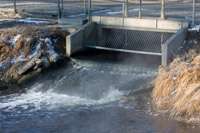Bacteria create aquatic superbugs in waste treatment plants

(PhysOrg.com) -- For bacteria in wastewater treatment plants, the stars align perfectly to create a hedonistic mating ground for antibiotic-resistant superbugs eventually discharged into streams and lakes.
In the first known study of its kind, Chuanwu Xi of the University of Michigan School of Public Health and his team sampled water containing the bacteria Acinetobacter at five sites in and near Ann Arbor's wastewater treatment plant.
They found the so-called superbugs—bacteria resistant to multiple antibiotics—up to 100 yards downstream from the discharge point into the Huron River. Xi stresses that while the finding may be disturbing, it is important to understand that much work is still needed to assess what risk, if any, the presence of superbugs in aquatic environments poses to humans.
"We still need to understand the link between aquatic and human multiple drug resistant bacteria," said Xi, assistant professor of public health.
Xi and colleagues found that while the total number of bacteria left in the final discharge effluent declined dramatically after treatment, the remaining bacteria was significantly more likely to resist multiple antibiotics than bacteria in water samples upstream. Some strains resisted as many as seven of eight antibiotics tested. The bacteria in samples taken 100 yards downstream also were more likely to resist multiple drugs than bacteria upstream.
"Twenty or 30 years ago, antibiotics would have killed most of these strains, no problem," he said.
Multiple antibiotic-resistant bacteria has emerged as one of the top public health issues worldwide in the last few decades as the overuse of antibiotics and other factors have caused bacteria to become resistant to common drugs. Xi's group chose to study Acinetobacter because it is a growing cause of hospital-acquired infections and because of its ability to acquire antibiotic resistance.
Xi said the problem isn't that treatment plants don't do a good job of cleaning the water—it's that they simply aren't equipped to remove all antibiotics and other pharmaceuticals entering the treatment plants.
The treatment process is fertile ground for the creation of superbugs because it encourages bacteria to grow and break down the organic matter. However, the good bacteria grow and replicate along with the bad. In the confined space, bacteria share resistant genetic materials, and remaining antibiotics and other stressors may select multi-drug resistant bacteria.
While scientists learn more about so-called superbugs, patients can do their part by not insisting on antibiotics for ailments that antibiotics don't treat, such as a common cold or the flu, Xi said. Also, instead of flushing unused drugs, they should be saved and disposed of at designated collection sites so they don't enter the sewer system.
The next step, said Xi, is to see how far downstream the superbugs survive and try to understand the link between aquatic and human superbugs. This study did not look past 100 yards.
More information: The study, "Wastewater treatment contributes to selective increases of antibiotic resistance among Acinetobacter spp." is available through advance online publication at: www.ncbi.nlm.nih.gov/pubmed/19321192?dopt=Abstract
Provided by University of Michigan (news : web)













